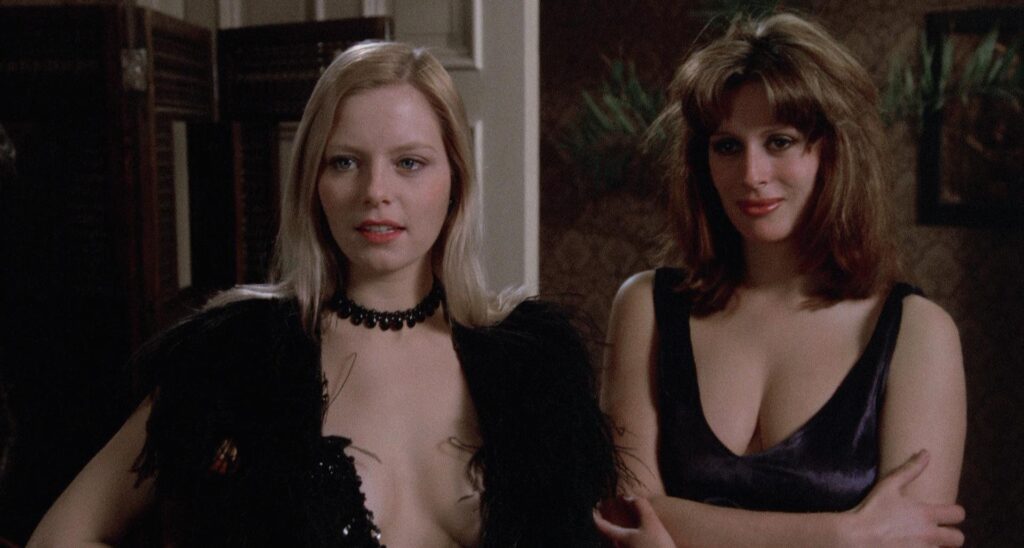
Vampyres opens with a scene of disturbing violence. Two women, in the midst of making love, are gunned down. Their naked bodies splattered with blood as bullets pass through them. Then director José Ramón Larraz cuts to black. Slowly bats begin to take wing and fly up into shot through the darkness as the titles begin to roll. These images or murder and nocturnal beasts are starkly minimal and set the tone for the remainder of the film.
Diana Daubeney’s screenplay for Vampyres is classically Gothic. Daubeney is more concerned with the questions provoked by the supernatural and unexplainable than in finding any answers. Larraz’s images of a rain drenched English countryside and expansive Victorian manors accents the Gothic nature of the script, giving it a visceral life that, as a series of signifiers, is instantly recognizable without ever feeling familiar. Comparisons could easily be made to the lesbian vampire films of Jean Rollin or the seventies Hammer Horror output, but Vampyres is subtly something wholly unique.
The image of two darkly shrouded women traipsing through the forest could come from any of Rollin’s films. But the slow building tension and the detail afforded to location escape the French auteur’s sensibilities which are shaped and defined by his limited means. Likewise the meandering nature of the pacing could never exist in a Hammer production concerned and invested in peddling gaudy spectacles of plastic gothic horror. Vampyres is unique because its aesthetic sensibilities exist entirely between these two extremes. Larraz’s film unfolds with the suspense of a slow burning mystery that is couched in the visual milieu of the Gothic.
Vampyres really begins after the credits as the camera follows Harriet (Sally Faulkner) and her boyfriend John (Brian Deacon) on vacation in their caravan. While they drive into the country they pass two women in long black coats who appear to be hitchhiking. Immediately Harriet’s imagination runs away with her and she becomes entranced by the image of these two women. The women, Fran (Marianne Morris) and Miriam (Anulka Dziubinska), are a vampire couple who emerge from their ghostly chateau at dusk to wander the back roads of the country looking for victims on which to feed. They lure these motorists back to their mansion with the pretense of a small party only to drug them and drink their blood. Unbeknownst to Fran and Miriam, Harriet is camping out on the edge of their property and playing the amateur sleuth.
Daubeney structures the film so that the audience learns about these women vampires very gradually and from two distinct perspectives. On the outside of the manor there is Harriet while within there is the willing victim Ted (Murray Brown). Ted sees some of the more fantastic goings on but is eager to rationalize them away just as Harriet’s boyfriend John talks her out of her convictions. Each of these parallel investigations unfold slowly as evidence of vampirism becomes more and more difficult to ignore. Larraz cleverly repeats images that are unique to each narrative tract creating a series of rhyming motifs.
As the film resolves Harriet and John are dead while Ted escapes the vampires in his car, weak from the loss of blood. When he awakens he’s on the estate, groggy in the driver’s seat with an empty bottle of wine beside him. A realtor, who is there to show the property, wakes him up and scolds him for trespassing. Then we overhear, just as Ted overhears, the realtor tell his clients about the legend of the house; how two women were found murdered there many years ago.
This conclusion blurs the lines between reality and fantasy. It’s a little on the nose but it’s effective, primarily because the doubt is sowed by a character other than Ted. This ending reframes and illuminates much of what Larraz has shown the audience before, casting it in the light of a discourse regarding the spectator’s role in conjuring illusions. Vampyres is one of those cult films that manages to be as intellectually engaging as it is titillating. It’s the perfect movie for a brisk October evening.
